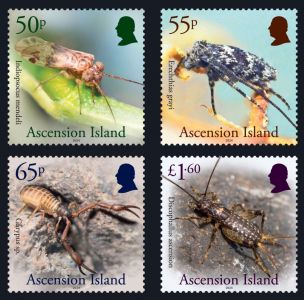
In fact, the majority of species unique to Ascension are invertebrates - they have no backbone. Ascension's so-called "endemic" invertebrates are reclusive and difficult to find. Early explorers dismissed the island's apparently-lacking biodiversity. Had they looked a little closer, they would have been surprised.
Ascension’s rolling volcanic landscapes accommodate around 30 endemic invertebrate species. Surviving such harsh environments requires ingenious evolutionary adaptation. From spiders to springtails, the invertebrates have all found some way of getting by. Their varied life strategies are as fascinating as their distinct methods of colonization.
Endemic crickets adorned with fish-like scales (Discophallus species) patrol the coastlines after dark. Rarely seen, they are the secretive clean-up crew of detritus and carcasses. The Discophallus are natural sailors - their ancestors likely reached Ascension atop driftwood.
Other invertebrates took to the air. Mendel’s barkfly (Indiopsocus mendeli) is incapable of flying such a distance unaided. Its ancestors would have needed to travel on strong air currents. Native moths would have arrived by the same method. But, endemic Gray's fungus moth (Erechthias grayi) has reduced wings, incapable of flight. This minuscule species is enigmatic for its alternative running and hopping locomotion. It has adapted to exposed ridges, where large wings would parachute away in high winds.
Why go through the effort of flying when you could hitch a lift? Pseudoscorpions, distinct from scorpions for having no stinging tail, found the easy route. They would have clung to seabirds with their pincers to make the perilous journey. Ascension has five endemic species. One of those, the giant pseudoscorpion (Garypus titanius), is the world's largest. It has grown in size to fill a vacant ecological niche in the absence of larger land animals.
Despite such diverse evolutionary origins, all Ascension's endemic invertebrates face similar present-day threats. Introduction of non-native species to the island has caused extensive damage to habitats. Research and management is key to cementing the futures of these over-looked species
| Technical details: | |
| Values | 50p, 55p, 65p & £1.60 |
| Designer | Bee Design |
| Printer | Cartor |
| Process | Stochastic lithography |
| Perforation | 13 ¼ x 13 ½ per 2cms |
| Stamp size | 36 x 36mm |
| Sheet layout | 10 |
| Release date | 29 April 2024 |
| Production Co-ordination | Creative Direction (Worldwide) Ltd |
